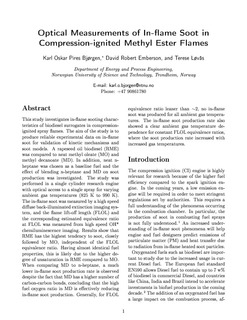| dc.contributor.author | Bjørgen, Karl Oskar Pires | |
| dc.contributor.author | Emberson, David | |
| dc.contributor.author | Løvås, Terese | |
| dc.date.accessioned | 2019-10-25T07:20:04Z | |
| dc.date.available | 2019-10-25T07:20:04Z | |
| dc.date.created | 2019-08-06T09:36:25Z | |
| dc.date.issued | 2019 | |
| dc.identifier.citation | Energy & Fuels. 2019, 33 7886-7900. | nb_NO |
| dc.identifier.issn | 0887-0624 | |
| dc.identifier.uri | http://hdl.handle.net/11250/2624323 | |
| dc.description.abstract | This study investigates in-flame sooting characteristics of biodiesel surrogates in compression-ignited spray flames. The aim of the study is to produce reliable experimental data on in-flame soot for validation of kinetic mechanisms and soot models. A rapeseed oil biodiesel [rapeseed oil methyl ester (RME)] was compared to neat methyl oleate (MO) and methyl decanoate (MD). In addition, neat n-heptane was chosen as a baseline fuel and the effect of blending n-heptane and MD on soot production was investigated. The study was performed in a single-cylinder research engine with optical access to a single spray for varying ambient gas temperatures (825–990 K). The in-flame soot was measured by a high-speed diffuse back-illuminated extinction imaging system, and the flame lift-off length (FLOL) and the corresponding estimated equivalence ratio at FLOL was measured from high-speed OH* chemiluminescence imaging. Results show that RME has the highest tendency to soot, closely followed by MO, independent of the FLOL equivalence ratio. Having almost identical fuel properties, this is likely due to the higher degree of unsaturation in RME compared to MO. When comparing MD to n-heptane, a much lower in-flame soot production rate is observed despite the fact that MD has a higher number of carbon–carbon bonds, concluding that the high fuel oxygen ratio in MD is effectively reducing in-flame soot production. Generally, for FLOL equivalence ratio leaner than ∼2, no in-flame soot was produced for all ambient gas temperatures. The in-flame soot production rate also showed a clear ambient gas temperature dependence for constant FLOL equivalence ratios, where the soot production rate increased with increased gas temperatures. | nb_NO |
| dc.language.iso | eng | nb_NO |
| dc.publisher | American Chemical Society | nb_NO |
| dc.title | Optical Measurements of In-Flame Soot in Compression-Ignited Methyl Ester Flames | nb_NO |
| dc.type | Journal article | nb_NO |
| dc.type | Peer reviewed | nb_NO |
| dc.description.version | acceptedVersion | nb_NO |
| dc.source.pagenumber | 7886-7900 | nb_NO |
| dc.source.volume | 33 | nb_NO |
| dc.source.journal | Energy & Fuels | nb_NO |
| dc.identifier.doi | 10.1021/acs.energyfuels.9b01467 | |
| dc.identifier.cristin | 1714203 | |
| dc.description.localcode | Locked until 5.7.2020 due to copyright restrictions. This document is the Accepted Manuscript version of a Published Work that appeared in final form in [Energy & Fuels], copyright © American Chemical Society after peer review and technical editing by the publisher. To access the final edited and published work see [insert ACS Articles on Request author-directed link to Published Work, see http://pubs.acs.org/page/policy/articlesonrequest/index.html].” | nb_NO |
| cristin.unitcode | 194,64,25,0 | |
| cristin.unitname | Institutt for energi- og prosessteknikk | |
| cristin.ispublished | true | |
| cristin.qualitycode | 2 | |
